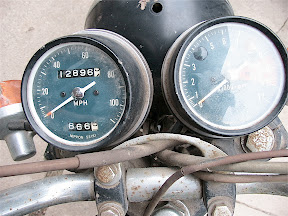For example…
When I was a teenager my first bike was a 1976 Yamaha XS650 (the "Custom", I believe). I bought the bike for $125.00 from an ad in the Janesville Gazette. The bike was drivable and I was able to ride it home that day. When I got there I started going over the bike to see what needed to be done. All the typical items (tires, battery, etc.) looked like they would need replacement but in addition there were a few things I didn't expect as well. In particular, the lever for the choke was missing.
Now this is a tiny piece of metal with a little bit of a rubber/plastic handle on it and a mounting screw. Based on this I figured it would cost about $5.00 at most so I called up the local parts shop to have them order it. You can imagine my surprise when the total came to about $40.00.
That's just crazy!
As it turned out, this was just the beginning of the pain as the bike would later need a new airbox, rectifier and other various items which had they been ordered directly from the parts place would have easily put the cost of the bike over the $1000.00 mark, and that's before replacing the tires and the battery.
Needless to say buying these parts just wasn't in the cards on my Musicland salary and I had to improvise, leading to additional "learning experiences" down the road; but I digress.
Had Ebay existed back then, things might have been different.
The bike I'm working on now, my CL350, came with a few "questionable" or just plain broken parts as well. I noticed that in addition to the rust the exhaust system has suffered there was also a bracket that was just plain broken. It might be possible for me to fabricate a replacement but it just so happens that I was able to find a NOS (New old-stock) piece on Ebay for about $5.00 (yes I see the irony in the pricing). The stator cover was also damaged at some point (from the looks of it, pierced by the shift lever when the bike went down on the left side). The cover has been repaired with what appears to be JB Weld, but since I was able to find a replacement one for $6.00 on Ebay I picked it up, I'll keep the original as a spare.
 I was also able to find a NOS shift lever (the one I have is still a bit crooked and missing the rubber bits) but at $15.00 it's just a little more than the part is worth to me, at least for now. I'll wait until a better bit comes along.
I was also able to find a NOS shift lever (the one I have is still a bit crooked and missing the rubber bits) but at $15.00 it's just a little more than the part is worth to me, at least for now. I'll wait until a better bit comes along.I'm sure that Ebay is just as much a boon to those selling these items as it is to people like me buying them. Now that box of parts in their garage can be turned into cash for other projects, and I know I feel better about contributing to that than the insane markup of a parts dealer.






